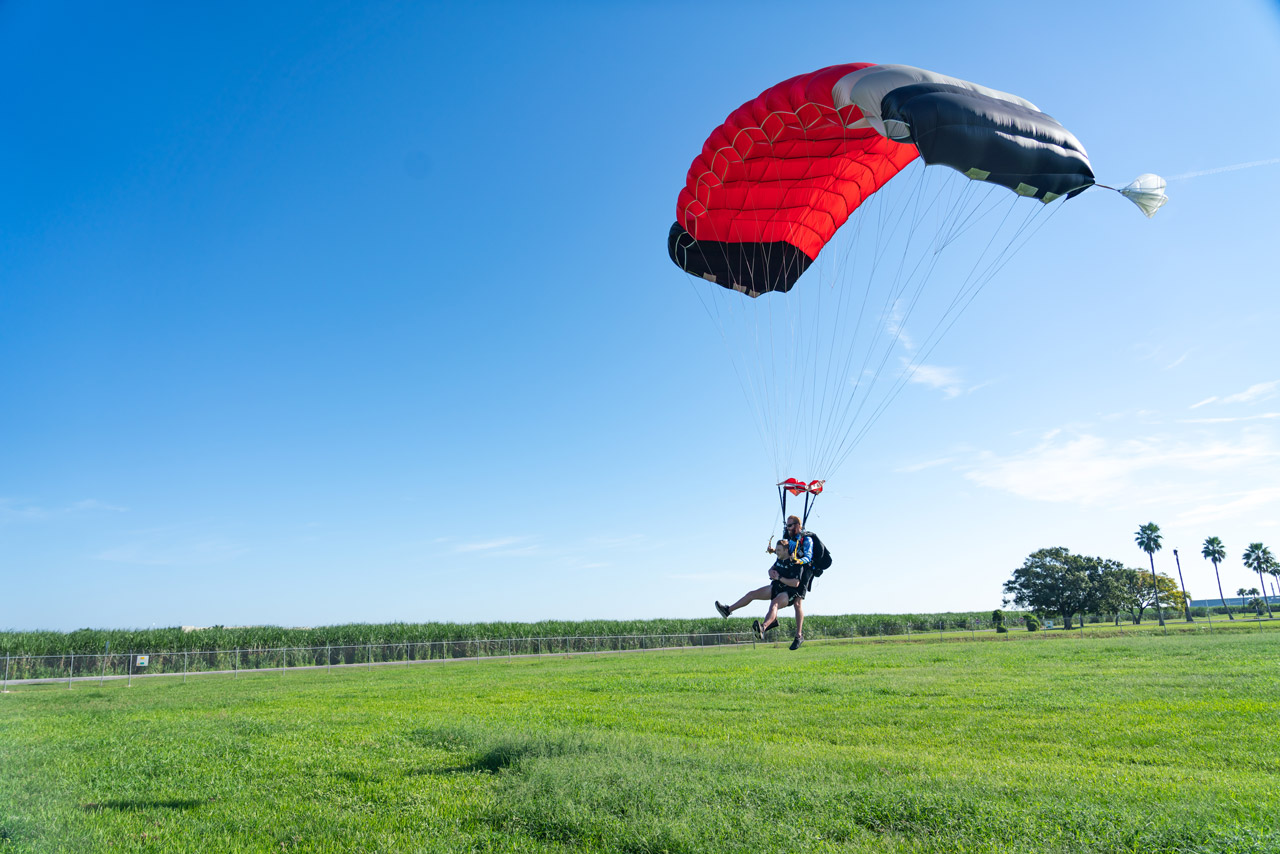Parachute Cost, Types, & Weight Limits: Everything You Need to Know
Skydiving
Posted by: Skydive Palm Beach
6 months ago
Skydiving captivates many, and while it might appear straightforward at first glance, skydiving is a complex and nuanced world. Numerous questions arise regarding the equipment that makes the leap possible:
- What are the different kinds of parachutes?
- How much weight can a parachute hold?
- How much do parachutes cost?
- And where can you buy a parachute?
This article sheds light on these questions, focusing primarily on the main types of parachutes used in civilian and military parachute jumps.

Unraveling the Types of Parachutes
At the heart of skydiving lies the parachute. Both sport and military jumpers deploy two main types: round and RAM air parachutes. In both cases, the jumper will be equipped with a main and a reserve parachute. The main parachute sees regular use and is incorporated into every jump, while the reserve parachute is there for emergencies, requiring packing and servicing by a rigger certified by the Federal Aviation Administration (FAA).
Round Parachutes
Characterized by their circular or semi-circular canopy shape, round parachutes were among the earliest designs and were widely used in military operations and the early days of skydiving. They offered limited control, with little to no maneuverability, and often resulted in hard landings.
So, why do paratroopers still use round parachutes? Round parachutes have a proven track record of successful deployments and landings, making them suitable for military drops where reliability is crucial, for example, a mass deployment of troops and cargo. However, their use today is mostly confined to emergency bailouts for pilots or certain military applications.

RAM Air Parachutes
When we discuss what shape of parachute is most effective, we draw our attention to the RAM air parachute – also known as a canopy or wing. RAM air parachutes, with their rectangular canopy design, allow air to enter through the nose of the canopy, creating a wing-like shape known as an airfoil. This design facilitates maneuvers such as turns and flares, enabling a more accurate and softer landing.
This is the primary difference between a round parachute and a RAM air parachute: controllability. Not surprisingly, then, the superior performance and safety features of a RAM air canopy make them the standard skydiving parachute for sport jumpers.

Elliptical Parachutes
The elliptical parachute is a specialized form of the RAM air parachute. Their tapered design provides superior aerodynamics, appealing to experienced skydivers seeking higher performance. Elliptical parachutes range from slightly tapered designs that are a step up from the rectangular ones to highly aggressive, competition-level wings requiring advanced skills.
Imagine comparing your modern rectangular parachute to a reliable family sedan, whereas an elliptical parachute is akin to a sports car, demanding a more experienced pilot.
Understanding Parachute Weight Limits
What is the weight limit of a parachute? Parachute weight limits vary depending on factors such as the type of jump, parachute model, and manufacturer’s guidelines. The weight limit for a parachute jump is not a one-size-fits-all but a variable dependent on many factors.
All main and reserve parachutes have weight limits determined by factors like canopy size, design, and material strength, ensuring safe deployments and landings. For example, tandem skydiving equipment, like that used at Skydive Palm Beach, has specific weight limits – which is why the weight limit for a parachute jump with us is under 240 lbs. If this number seems low, consider that our limit has to factor in the weight of two people. The typical tandem parachute weight limit is 500 lbs – which must include your weight, your instructor’s weight, and the 50+ lbs of non-negotiable equipment that’s in the mix.
Military chutes, on the other hand, are designed for very heavy loads and can support weights of between 2,500 and 10,000 lbs!

How Much is a Parachute for Skydiving?
So, how much does a parachute cost? Parachute pricing spans a broad spectrum, from $1,000 for a reliable second-hand parachute to over $5,000 for a tandem parachute. However, it is important to note that when we discuss how much parachutes cost, this is only one component of a skydiving container.
A full tandem skydiving container, for example, consists of a main parachute, a reserve parachute, a tandem passenger harness, and an automatic activation device, with a complete tandem system potentially costing $20,000+. This variance underscores the importance of understanding what you’re paying for when you sign up for a tandem skydive – a complex assembly of equipment engineered for safety and performance!
Gear Acquisition: A Guided Journey
Embarking on your skydiving journey necessitates the right equipment, and guidance from seasoned instructors and riggers is invaluable. Beginners typically start with larger, more forgiving parachutes, with the investment in personal gear later in the skydiving progression. Numerous reputable vendors, both online and in-store, offer quality skydiving gear, ensuring you’re ready for the skies.

Ready to Fly?
Equipped with a deeper understanding of skydiving’s vital components, you’re now closer to experiencing the unmatched exhilaration of freefall and that breathtaking parachute ride. So, what are you waiting for? Book your tandem skydive and embark on the adventure of a lifetime! Blue skies!




